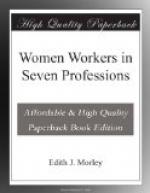“Inasmuch as the Insurance Commission is the first Government Department in which a woman staff has been appointed from the outset, special mention may be made of one portion of the work carried out by the women inspectors during the past year. The enquiry held in the autumn by Mr Pope on the objections raised to the inclusion of married women outworkers within the provisions of Part I. of the Act necessitated much careful investigation among employers and outworkers in a large number of trades all over the country, such as tailoring, glove-making, lace manufacture, carding of hooks and eyes, pins and needles, buttons and fish-hooks at Birmingham, net-making at Bridport, chain-making at Cradley Heath, straw hat-making at Luton, chair-making, box-making, and boot, shoe, and hosiery manufacture. This investigation was undertaken by the women staff. The enquiry entailed hundreds of visits, both in the poorest parts of industrial towns and in remote country districts, and in interviews with employers and workers great tact and patience were required. Of the evidence given by the women inspectors, Mr Pope reports that they ’one and all gave evidence with extreme moderation, impartiality and discretion. The conspicuous fairness and the success with which they had collected information were frequently a matter of commendation from employers, who informed me that the enquiry had afforded them information about their own trades which years of work in it had not made known to them.’”
The General Post Office
This paper would not be complete without some reference to the large number—now nearly 3,000—of women clerks employed by the General Post Office, all of whom enter the service by open competition, either as girl clerks between sixteen and eighteen years of age or as women clerks between eighteen and twenty. Their duties are necessarily of a clerical nature, and in their earlier years at least they can hardly, perhaps, be included in the “higher grades.” Yet the supervisory posts which become necessary wherever large numbers of workers are employed call for considerable administrative ability and are proportionately better remunerated. All women clerks are eligible for these posts, and indeed they are never filled in any other way.
The highest post open to a woman clerk in the General Post Office is that of Superintendent at the Savings Bank, the present holder of which is on a scale of L350-20-L600. There are 4 Deputy Superintendents at L270-15-L330; 13 Assistant Superintendents at L210-10-L260; and 53 Principal Clerks at L150-10-L200. The Savings Bank has the largest group of women clerks—numbering 1,210—of any department, and of these 150 are in the first class.
The next largest group of Women Clerks is in the Money Order Department; in this office the women outnumber the men in the proportion of 5 to 1. They number 592, of whom 67 are in the first class. There is one Superintendent at L350-20-L500; 1 Deputy Superintendent at L270-15-L330; 5 Assistant Superintendents at L210-10-L260; and 24 Principal Clerks at L150-10-L200.




